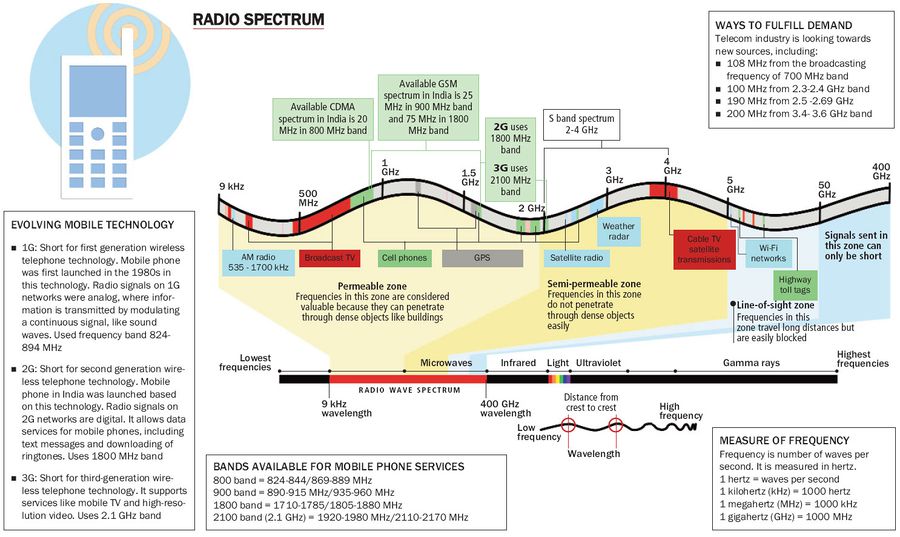Difference between revisions of "Spectrum"
(Added 2016 Graphic on spectrum) |
|||
| Line 1: | Line 1: | ||
== Spectrum == | == Spectrum == | ||
| + | As a rule | ||
| + | Higher frequency means higher data badwidth but lesser range | ||
| + | Sub GHZ can more easily pentrate cement walls, tree coverage | ||
| + | |||
| + | Internayional ISM bands and convergence | ||
| − | |||
https://www.brookings.edu/wp-content/uploads/2016/06/Spectrum-Policy-in-India8515.pdf | https://www.brookings.edu/wp-content/uploads/2016/06/Spectrum-Policy-in-India8515.pdf | ||
===National Allocation=== | ===National Allocation=== | ||
| + | |||
| + | [[File:Spectrum Regulation Arvind.jpg| link=http://cdn.downtoearth.org.in/mobile-20110315.jpg|900px| Primer on Spectrum in India]] | ||
===Military and other uses=== | ===Military and other uses=== | ||
=== Convergence with ITU band others=== | === Convergence with ITU band others=== | ||
== Licensed Operators == | == Licensed Operators == | ||
| − | === | + | ===Network Bands Used in India=== |
| − | https://telecomtalk.info/india-spectrum-data-sheet/134245/ | + | |
| − | https://www.frequencycheck.com/countries/india | + | |
| + | |||
| + | In India, GSM telephony works on two different frequency bands GSM900 and GSM1800 in MHz(mega hertz). Lower frequency network bands offers higher coverage while higher frequency network bands offers higher data speeds. | ||
| + | |||
| + | HSPA telephony in India works on two different network bands UMTS900 and UMTS 2100 in MHz. UMTS network bands are radio frequencies used by 3G. UMTS network bands in India are commonly deployed at 2100 MHz for better speeds. | ||
| + | |||
| + | LTE Technology in India make use of 3 network bands namely LTE850 (Band 5), LTE1800(Band 3), LTE2300 (Band 40). Band 3 provided great network coverage while Band 40 0ffers greater data speeds. | ||
| + | |||
| + | |||
| + | *https://telecomtalk.info/india-spectrum-data-sheet/134245/ | ||
| + | *https://www.frequencycheck.com/countries/india | ||
Revision as of 06:20, 6 November 2017
Contents
Spectrum
As a rule Higher frequency means higher data badwidth but lesser range Sub GHZ can more easily pentrate cement walls, tree coverage
Internayional ISM bands and convergence
https://www.brookings.edu/wp-content/uploads/2016/06/Spectrum-Policy-in-India8515.pdf
National Allocation
Military and other uses
Convergence with ITU band others
Licensed Operators
Network Bands Used in India
In India, GSM telephony works on two different frequency bands GSM900 and GSM1800 in MHz(mega hertz). Lower frequency network bands offers higher coverage while higher frequency network bands offers higher data speeds.
HSPA telephony in India works on two different network bands UMTS900 and UMTS 2100 in MHz. UMTS network bands are radio frequencies used by 3G. UMTS network bands in India are commonly deployed at 2100 MHz for better speeds.
LTE Technology in India make use of 3 network bands namely LTE850 (Band 5), LTE1800(Band 3), LTE2300 (Band 40). Band 3 provided great network coverage while Band 40 0ffers greater data speeds.
